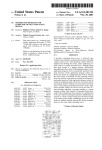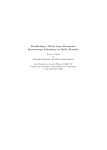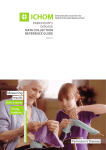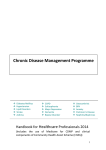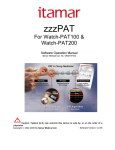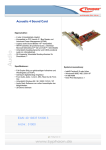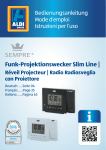Download Control Baseline Visit (BL)
Transcript
PPMI Source Worksheets Baseline Visit PPMI VITAL SIGNS 1 3 2 2 6 SUBJECT ID INITIALS VISIT NO SITE NO VISIT DATE MM DD YYYY 1. 1. Weight (in Kilograms) - Baseline and Annual only 2. Height (in Centimeters) - Baseline and Annual only 3. Temperature (in Celsius) 4. Arm used to measure blood pressure? (1 = Right arm, 2 = Left arm) 5. Supine blood pressure: systolic/diastolic (mmHg) (to be taken after subject has been supine for 1-3 minutes) 6. Supine heart rate (beats per minute) (to be taken after subject has been supine for 1-3 minutes) 9. Standing blood pressure: systolic/diastolic (mmHg) (to be taken after subject has been standing for 1-3 minutes) 10. Standing heart rate (beats per minute) (to be taken after subject has been standing for 1-3 minutes) 11. Comments: . 2. 3. . 4. 5. 6. 9. 10. _______________________________________________________________ _______________________________________________________________ _______________________________________________________________ Copyright © 2004 University of Rochester. All Rights Reserved. (10/17/07) 5/6/10 Page 1 of 1 PPMI MDS-UPDRS REFER TO MDS-UPDRS PACKET AND SCORE SHEET TO CONDUCT THE FULL MDS-UPDRS AND HOEHN & YAHR PPMI HOPKINS VERBAL LEARNING TEST - REVISED 1 3 2 SUBJECT ID INITIALS 3 6 VISIT NO SITE NO VISIT DATE MM DD YYYY Record scores below from the HVLT-R Test Booklet. 1. 2. Hopkins Verbal Learning Test - Revised 1.1 Immediate Recall Trial 1 (# correct) 1. 1 1.2 Immediate Recall Trial 2 (# correct) 1. 2 1.3 Immediate Recall Trial 3 (# correct) 1. 3 1.4 Delayed Recall Trial 4 (# correct after 20 minutes delay) 1. 4 1.5 Delayed recognition - Total # of true - positive responses (“hits”) 1. 5 1.6 Delayed recognition - # of related false - positive errors 1. 6 1.7 Delayed recognition - # of unrelated false - positive errors 1. 7 Indicate the HVLT-R test booklet used at this visit (if different than indicated in the protocol, comment below): Form 1 Form 2 Form 3 Form 4 Form 5 Form 6 Comment:_________________________________________________________________________ ________________________________________________________________________________ ________________________________________________________________________________ “Adapted and reproduced by special permission of the Publisher, Psychological Assessment Resources, Inc., 16204 North Florida Avenue, Lutz, Florida 33549, from the Hopkins Verbal Learning Test-Revised by Jason Brandt, PhD and Ralph H.B. Benedict, PhD, Copyright 1991, 1998, 2001 by PAR, Inc. Further reproduction is prohibited without permission from PAR, Inc.” (10/16/07) 4/23/12 Page 1 of 1 PPMI LINE ORIENTATION REFER TO BENTON JUDGMENT OF LINE ORIENTATION – FORM H RECORD SHEET COMPLETE ONLY THE ODD TEST ITEMS AT BASELINE, MONTH 24 (V06), MONTH 48 (V10) LINE ORIENTATION NOTES (CHECK OPERATIONS MANUAL AS NECESSARY) Booklet in front of subject, opened so that stimulus items in upper half are at an angle of about 45. Subject is allowed to position booklet to their best advantage (within reason). Explaining the task, as necessary, during the Practice Items is critical. PRACTICE ITEM A: “Which two numbered lines [point to numbered lines] are in exactly the same position and point in the same direction as the two lines up here?” If subject supplies correct responses, say That’s right, and proceed to Practice Item B, then C, and so on. Administer all Practice Items (A through E). When a subject fails to give a correct response for both lines (e.g., 1 & 6 for Practice Item A), follow the extended instructions given in the Operations Manual. If subject tends to misstate the numbers but points to the correct responses, say instead: Show me these lines down here. Point to them. If subject does not understand the task and/or does not supply a correct response for any of the practice items, follow the “Extended Instructions” provided in the Operations Manual. STARTING THE TEST: Open booklet at page labeled “Test Items”. Say: “Now we are going to do more of these, except now the lines which you see up here [point to the upper page] will be shorter, because part of the line has been erased. Tell me [Show me] which two lines down here are pointing in the same direction as the lines up here.” Provide encouragement, but not right/wrong feedback. Be careful to avoid giving non-verbal cues regarding response accuracy. o E.g., hesitancy before moving on. Behave in exactly the same way regardless of whether the responses are right or wrong.* No response within 30 seconds: encourage subject to make their best guess. However, there is no time limit for responding. The subject’s actual responses should be entered on the Record Form (not just “right” or “wrong”). Spontaneous corrections by the subject are accepted. Both responses must be correct for the item to be scored as correct. The correct responses are printed on the work sheet. Place a check next to correct items. Data entry is item by item rather than by total correct. Complete all 15 Test Items Score range: 0 - 15 * There is one exception to this rule. THIS INTERVENTION SHOULD OCCUR VERY RARELY. Occasionally a subject will demonstrate reasonable spatial orientation (e.g., on the practice items or on earlier items), but then appears to forget what it is that the test requires. Evidence for this would be responses that are not at all close to being correct, or an indication that the subject is behaving in a highly distracted manner (e.g., giving an answer that suggests that they are giving two responses for one of the stimuli, and ignoring the other; or giving two responses from the same hemispace when the two stimuli lines are clearly on opposite sides of the page). If this occurs AND appears to represent a gross misunderstanding of the test despite earlier competence, ask the subject to show you/explain to you how they arrived at the response that they just offered you. Often this will reveal that they have mentally shifted to an incorrect understanding of the task requirements (e.g., they may be choosing lines based on the distance between them, rather than spatial orientation). Reinstruct as necessary, BUT DO NOT CROSS OVER THE LINE FROM CLARIFICATION TO TRAINING THEM TO DO BETTER. GO BACK TO THE PRACTICE ITEMS TO REINSTRUCT THE SUBJECT (RATHER THAN USING ACTUAL TEST ITEMS). NOTE THE INTERVENTION ON THE CRF. The reason for this “exception to the rule” is that when a spatially competent subject “loses set” on this test they will obtain a misleading very low score, especially since both responses per item must be correct to obtain credit. v. 05.05.10 PPMI SEMANTIC FLUENCY INSTRUCTIONS SAY: “I am going to give you a category and I want you to name, as fast as you can, all of the things that belong in that category. For example, if I say ‘articles of clothing,’ you could say ‘shirt,’ ‘tie,’ or ‘hat.’ Can you think of other articles of clothing?” Allow up to 20 seconds for the subject to produce two responses. If they cannot, clarify the task as best you can and then proceed with the actual testing (Animals, Vegetables, Fruits). Time limit: 60 seconds per trial. Response recording: Try to capture verbatim, but if you can’t keep up with at least the first syllable of a response, use a check-mark until you can. • Written recording helps you catch repetitions and incorrect responses. It also allows others to review your scoring. Consider audio-taping with appropriate consent. Scoring. The scoring is liberal and follows ADNI. Productivity is favored over semantic exactness. Animals score = total number of correct unique animal names produced within 60 seconds. ¾ CREDIT: breeds (e.g., terriers); male, female, and infant names of a species (e.g., bull, cow, calf); both superordinate and subordinate examples of a species (e.g., both dog and terrier are credited); birds; fish; reptiles, insects. ¾ DO NOT CREDIT: Repetitions, mythical animals. Vegetable = total number of correct unique names of vegetables produced within 60 seconds. ¾ CREDIT: Both superordinate and subordinate responses (e.g., peppers and jalapenos are credited); less specific names (e.g., greens); nuts (e.g., peanuts, acorns); and grains such as corn or rice. o o o o ¾ Names of vegetables found in other cultures but perhaps unfamiliar to you (e.g., Jicama) are acceptable only if they can be verified in the dictionary. After completion of the task, ask the subject to spell the word if you are unsure of the correct spelling & wish to check on the item. Grains (e.g. rice, wheat, oats, etc.), gourds, sugarcane, herbs and seaweed are counted as acceptable ‘vegetable’ responses. Tomato, avocado and pumpkin are acceptable responses. DO NOT CREDIT: Repetitions. Prepared vegetable products are not acceptable responses (e.g. pickles, tomato sauce, ketchup, etc.). Fruit = Total number of correct unique names of fruits produced within 60 seconds. Some items (e.g. tomato, avocado) count as either a fruit or vegetable, but you should only give credit once, i.e., if the subject gives “tomato” as vegetable, and then again as a fruit, do not give credit the second time. Count raisins & sultanas as well as grapes. If you are uncertain of a response, after the completion of the trial ask the subject to spell the item so that you can check it in the dictionary &/or obtain opinions from other examiners. v. 05.05.10 PPMI SEMANTIC FLUENCY: ANIMALS Site Number:_______ Subject Number:___________ Visit Date:_______________ NAME AS MANY ANIMALS AS YOU CAN IN 60 SECONDS: Examiners: Write responses verbatim whenever possible; substitute checkmark only when you cannot keep up. Do not count repetitions. One prompt allowed if no response for 15 seconds, or patient states they cannot think of any more (“Please tell me all the animals you can think of…”). See Operations Manual for full instructions. 1 16 31 2 17 32 3 18 33 4 19 34 5 20 35 6 21 36 7 22 37 8 23 38 9 24 39 10 25 40 11 26 41 12 27 42 13 28 43 14 29 44 15 30 45 v. 04/27/10 PPMI SEMANTIC FLUENCY: VEGETABLES Site Number:_______ Subject Number:___________ Visit Date:_______________ NAME AS MANY VEGETABLES AS YOU CAN IN 60 SECONDS: Examiners: Write responses verbatim whenever possible; substitute checkmark only when you cannot keep up. Do not count repetitions. One prompt allowed if no response for 15 seconds, or patient states they cannot think of any more (“Please tell me all the vegetables you can think of…”). See Operations Manual for full instructions. 1 16 31 2 17 32 3 18 33 4 19 34 5 20 35 6 21 36 7 22 37 8 23 38 9 24 39 10 25 40 11 26 41 12 27 42 13 28 43 14 29 44 15 30 45 v. 04/27/10 PPMI SEMANTIC FLUENCY: FRUITS Site Number:_______ Subject Number:___________ Visit Date:_______________ NAME AS MANY FRUITS AS YOU CAN IN 60 SECONDS: Examiners: Write responses verbatim whenever possible; substitute checkmark only when you cannot keep up. Do not count repetitions. One prompt allowed if no response for 15 seconds, or patient states they cannot think of any more (“Please tell me all the fruits you can think of…”). See Operations Manual for full instructions. 1 16 31 2 17 32 3 18 33 4 19 34 5 20 35 6 21 36 7 22 37 8 23 38 9 24 39 10 25 40 11 26 41 12 27 42 13 28 43 14 29 44 15 30 45 v. 04/27/10 PPMI SEMANTIC FLUENCY 1 3 2 3 8 SUBJECT ID INITIALS VISIT NO SITE NO VISIT DATE MM DD YYYY 1. Record the number of animals named in one minute (60 seconds): 1. 2. Record the number of vegetables named in one minute (60 seconds): 2. 3. Record the number of fruits named in one minute (60 seconds): 3. Goodglass H. Assessment of aphasia and related disorders. Philadelphia: Lea and Febiger, 1972. 5/6/10 Page 1 of 1 PPMI LETTER-NUMBER SEQUENCING INSTRUCTIONS Definitions: An example of a trial is 1a. An example of an item 1a through 1c. Each item is composed of 3 trials. SAY: “I am going to say a group of numbers and letters. After I say them, I want you to repeat the numbers first, in order, starting with the lowest number. Then say the letters in alphabetical order. For example, if I say ‘B – 7’, your answer should be ‘7 – B. The number goes first, then the letter. If I say ‘9 – C – 3, then your answer should be ‘3 – 9 – C’, the numbers in order first, then the letters in alphabetical order. LET’S PRACTICE (correct responses are in parentheses). READ AT A RATE OF ABOUT ONE NUMBER OR LETTER PER SECOND. 6–F G–4 3–W–5 T–7–L 1–J–A (6 – F) (4 – G) (3 – 5 –W) (7 – L – T) (1 – A – J) If the subject makes an error on a practice item, correct him/her and repeat the instructions. This test can be confusing for subjects with cognitive decline, and it may take a little effort to help them understand it. HOWEVER, even if the subject fails all practice items, you must go ahead with the test. DISCONTINUE if a subject scores a 0 on all three trials of an item (e.g. “0” for 3a, 3b and 3c). Scoring: Record the subject’s response to each trial verbatim next to the item on the worksheet. A response is incorrect if a number or letter is omitted or if the numbers and letters are not said in the specified sequence. • As long as the numbers and letters are recalled in correct sequence, give credit if the examinee gives the letters before the numbers (even though this is counter to the instruction that the numbers be recited first). • Allow the subject to make self-corrections if they recognize that they are making an error but do not cue or prompt them to do so. • A clarification of the instructions may be offered if the subject requests it during the testing. • Do not repeat a letter-number sequence once you have read it to the subject. If the subject asks that you repeat a trial (saying they “didn’t catch it” or similar), say you can’t, give them the opportunity to attempt a response, then say “lets try another one” and go to the next trial. v. 05.05.10 PPMI LETTER - NUMBER SEQUENCING (PD) 1 3 2 SUBJECT ID INITIALS 4 0 VISIT NO SITE NO VISIT DATE MM DD YYYY Instructions: All responses should be recorded verbatim in the “Subject Response” section below. Score 1 for each correct response and 0 for each incorrect response. Discontinue Rule: After scores of 0 for all 3 trials of an item. Item Trial (Correct Response) Subject Response 1a. L - 2 (2 - L) 1a. 1b. 6 - P (6 - P) 1b. 1c. B - 5 (5 - B) 1c. 2a. F - 7 - L (7 - F - L) 2a. 2b. R - 4 - D (4 - D - R) 2b. 2c. H - 1 - 8 (1 - 8 - H) 2c. 3a. T - 9 - A - 3 (3 - 9 - A - T) 3a. 3b. V - 1 - J - 5 (1 - 5 - J - V) 3b. 3c. 7 - N - 4 - L (4 - 7 - L - N) 3c. 4a. 8 - D - 6 - G - 1 (1 - 6 - 8 - D - G) 4a. 4b. K - 2 - C - 7 - S (2 - 7 - C - K - S) 4b. 4c. 5 - P - 3 - Y - 9 (3 - 5 - 9 - P - Y) 4c. Wechsler Memory Scale - Third Edition (WMS-III). Copyright 1997 NCS Pearson, Inc. Reproduced with permission. All rights reserved. “Wechsler Memory Scale” and “WMS” are trademarks, in the US and/or other countries, of Pearson Education, Inc. or its affiliate(s). (3/16/09) Score (0 or 1) 5/6/10 Page 1 of 2 PPMI 1 3 2 LETTER - NUMBER SEQUENCING (PD) SUBJECT ID 4 0 VISIT NO Instructions: All responses should be recorded verbatim in the “Subject Response” section below. Score 1 for each correct response and 0 for each incorrect response. Discontinue Rule: After scores of 0 for all 3 trials of an item. Item Trial (Correct Response) Subject Response 5a. M - 4 - E - 7 - Q - 2 (2 - 4 - 7 - E - M - Q) 5a. 5b. W - 8 - H - 5 - F - 3 (3 - 5 - 8 - F - H - W) 5b. 5c. 6 - G - 9 - A - 2 - S (2 - 6 - 9 - A - G - S) 5c. 6a. R - 3 - B - 4 - Z - 1 - C (1 - 3 -4 - B - C - R - Z) 6a. 6b. 5 - T - 9 - J - 2 - X - 7 (2 - 5 - 7 - 9 - J - T - X) 6b. 6c. E - 1 - H - 8 - R - 4 - D (1 - 4 - 8 - D - E - H - R) 6c. 7a. 5 - H - 9 - S - 2 - N - 6 - A (2 - 5 - 6 - 9 - A - H - N - S) 7a. 7b. D - 1 - R - 9 - B - 4 - K - 3 (1 - 3 - 4 - 9 - B - D - K - R) 7b. 7c. 7 - M - 2 - T - 6 - F - 1 - Z (1 - 2 - 6 - 7 - F- M - T - Z) 7c. Wechsler Memory Scale - Third Edition (WMS-III). Copyright 1997 NCS Pearson, Inc. Reproduced with permission. All rights reserved. “Wechsler Memory Scale” and “WMS” are trademarks, in the US and/or other countries, of Pearson Education, Inc. or its affiliate(s). (3/16/09) Score (0 or 1) 5/6/10 Page 2 of 2 PPMI SYMBOL DIGIT MODALIITES TEST INSTRUCTIONS – FORM 1 NOTE TO WAIS-III/IV USERS: TIME LIMIT IS 90 SECONDS! Administration: Place the test form on the table in front of the subject and say, Look at the boxes at the top of the page. Each box in the upper row has a symbol in it, and each box below it has a number. Now look at the next line of boxes [point to the first line of boxes without numbers]. Notice that the boxes on the top have symbols, but the boxes beneath are empty. You are to fill in each empty box with the number that goes with each symbol, according to the way they are paired at the top of the page. For example, if you look at the first symbol, [point to the first symbol in the row beneath the key], and then look up at the key, you see that this symbol is paired with the number “4” [show the pairing]. So, you would write a “4” in this box [write a “4” in the first box]. This next symbol [point to the next symbol] is paired with “6”, so you would put a “6” in this box [write “6” in the second box]. Now, what number goes in this box [point to third box]? These instructions may differ, depending on the version of the form being used. Subject should say “nine.” If not, correct the subject and explain the error. When the subject appears to comprehend the task, say, Good. Now, for practice, fill in the boxes up to this double line, and then stop. Correct immediately any errors made during the practice period, explaining the subject’s error. Repeat the instructions and review the correct coding of the practice boxes as necessary until the subject understands the task. Continue with the test by saying, When I say “Go,” write in the numbers just like you have been doing as fast as you can until I say “Stop.” Work as quickly as you can, moving from one line to the next, without skipping any boxes. If you make a mistake, cross it out and write the correct answer below. Remember to work as quickly as you can. Ready? Go! Start timing. Do not allow the subject to skip any boxes. At the end of 90 seconds, say, “STOP!” Be sure that the subject does not continue working after the time limit is reached. The score is the number of correct responses in 90 seconds. Do not include the practice items or incorrect responses in the total score. Score range: 0 - 110 v. 08.19.10 FORM I KEY SUBJECT ID _______________ Material from the copyright © 1973, 1976, 1982 by Western Psychological Services. Format adapted by M. Hunter, University of Rochester Medical Center, for specific, limited research use under license of the publisher, WPS, 12031 Wilshire Boulevard, Los Angeles, California 90025, U.S.A. (www.wpspublish.com). No additional reproduction, in whole or in part, by any medium or for any purpose, may be made without the prior, written authorization of WPS. All rights reserved. PPMI SYMBOL DIGIT MODALITIES TEST 1 3 2 SUBJECT ID INITIALS 4 2 VISIT NO SITE NO VISIT DATE MM DD 1. Total correct (Response should be 0-110) YYYY 1. 2. Indicate the form used at this visit (if different than indicated in the protocol, comment below): Form 1 Form 2 Comment:________________________________________________________________________ _______________________________________________________________________________ _______________________________________________________________________________ Material from the copyright © 1973, 1976, 1982 by Western Psychological Services. Format adapted by M. Hunter, University of Rochester Medical Center, for specific, limited research use under license of the publisher, WPS, 12031 Wilshire Boulevard, Los Angeles, California 90025, U.S.A. (www.wpspublish.com). No additional reproduction, in whole or in part, by any medium or for any purpose, may be made without the prior, written authorization of WPS. All rights reserved. 4/23/12 Page 1 of 1 REMINDER HOPKINS VERBAL LEARNING TEST DELAYED RECALL TRIAL (TRIAL 4) SHOULD BE DONE NOW After Symbol-Digit Before the Hopkins Recognition Trial v. 04/28/10 REMINDER THE HOPKINS VERBAL LEARNING RECOGNITION TRIAL SHOULD BE DONE NOW After Hopkins Delayed Recall (Trial 4) v. 05/26/10 PPMI EPWORTH SLEEPINESS SCALE 1 3 2 SUBJECT ID VISIT NO INITIALS SITE NO VISIT DATE MM A. 4 4 DD Source of Information: 1 = Patient, 2 = Caregiver, 3 = Patient and caregiver YYYY A. How likely are you to doze off or fall asleep in situations described below, in contrast to feeling just tired? This refers to your usual way of life in recent times. Even if you haven’t done some of these things recently try to work out how they would have affected you. Use the following scale to choose the most appropriate number for each situation: 0 = would never doze 1 = slight chance of dozing 2 = moderate chance of dozing 3 = high chance of dozing It is important that you answer each question as best you can. 1. Sitting and reading 1. 2. Watching TV 2. 3. Sitting, inactive in a public place (e.g., a theatre or a meeting) 3. 4. As a passenger in a car for an hour without a break 4. 5. Lying down to rest in the afternoon when circumstances permit 5. 6. Sitting and talking to someone 6. 7. Sitting quietly after a lunch without alcohol 7. 8. In a car, while stopped for a few minutes in the traffic 8. © M. W. Johns 1990-1997 5/6/10 Page 1 of 1 PPMI REM SLEEP DISORDER QUESTIONNAIRE 1 3 2 SUBJECT ID INITIALS 4 6 VISIT NO SITE NO VISIT DATE MM DD YYYY A. Source of Information: 1 = Patient, 2 = Caregiver, 3 = Patient and caregiver A. 1. I sometimes have very vivid dreams. (0 = No, 1 = Yes) 1. 2. My dreams frequently have an aggressive or action-packed content. (0 = No, 1 = Yes) 2. 3. The dream contents mostly match my nocturnal behaviour. (0 = No, 1 = Yes) 3. 4. I know that my arms or legs move when I sleep. (0 = No, 1 = Yes) 4. 5. It thereby happened that I (almost) hurt my bed partner or myself. (0 = No, 1 = Yes) 5. 6. I have or had the following phenomena during my dreams: 6.1 speaking, shouting, swearing, laughing loudly (0 = No, 1 = Yes) 6.1 6.2 sudden limb movements, “fights” (0 = No, 1 = Yes) 6.2 6.3 gestures, complex movements, that are useless during sleep, e.g., to wave, to salute, to frighten mosquitoes, falls off the bed (0 = No, 1 = Yes) 6.3 6.4 things that fell down around the bed, e.g., bedside lamp, book, glasses (0 = No, 1 = Yes) 6.4 7. It happens that my movements awake me. (0 = No, 1 = Yes) 7. 8. After awakening I mostly remember the content of my dreams well. (0 = No, 1 = Yes) 8. 9. My sleep is frequently disturbed. (0 = No, 1 = Yes) 9. Stiasny-Kolster, K et al. The REM Sleep Behavior Disorder Screening Questionnaire - A New Diagnostic Instrument. Movement Disorders.2007; 22(16):2386-2393. 5/6/10 Page 1 of 2 PPMI REM SLEEP DISORDER QUESTIONNAIRE 1 3 2 SUBJECT ID 10. 4 6 VISIT NO I have/had a disease of the nervous system: (0 = No, 1 = Yes) 10a. stroke 10a. 10b. head trauma 10b. 10c. parkinsonism 10c. 10d. RLS 10d. 10e. narcolepsy 10e. 10f. depression 10f. 10g. epilepsy 10g. 10h. inflammatory disease of the brain 10h. 10i. other, specify: _______________________________ Stiasny-Kolster, K et al. The REM Sleep Behavior Disorder Screening Questionnaire - A New Diagnostic Instrument. Movement Disorders.2007; 22(16):2386-2393. 10i. 5/6/10 Page 2 of 2 1 3 2 PPMI GERIATRIC DEPRESSION SCALE (Short Version) SUBJECT ID INITIALS 4 8 VISIT NO SITE NO VISIT DATE MM DD YYYY Choose the best answer for how you have felt over the past week. (0 = No, 1 = Yes) 1. Are you basically satisfied with your life? 1. 2. Have you dropped many of your activities and interests? 2. 3. Do you feel that your life is empty? 3. 4. Do you often get bored? 4. 5. Are you in good spirits most of the time? 5. 6. Are you afraid that something bad is going to happen to you? 6. 7. Do you feel happy most of the time? 7. 8. Do you often feel helpless? 8. 9. Do you prefer to stay at home, rather than going out and doing new things? 9. 10. Do you feel you have more problems with memory than most? 10. 11. Do you think it is wonderful to be alive now? 11. 12. Do you feel pretty worthless the way you are now? 12. 13. Do you feel full of energy? 13. 14. Do you feel that your situation is hopeless? 14. 15. Do you think that most people are better off than you are? 15. Sheikh JI, Yesavage JA: Geriatric Depression Scale (GDS): Recent evidence and development of a shorter version. Clinical Gerontology: A Guide to Assessment and Intervention. 165-173, NY: The Haworth Press, 1986. (10/16/07) 5/6/10 Page 1 of 1 SELF-EVALUATION QUESTIONNAIRE STAI Form Y-1 Please provide the following information: Name Age Date Gender (Circle) M S F T DIRECTIONS: A number of statements which people have used to describe themselves are given below. Read each statement and then circle the appropriate number to the right of the statement to indicate how you feel right now, that is, at this moment. There are no right or wrong answers. Do not spend too much time on any one statement but give the answer which seems to describe your present feelings best. 1. I feel calm ............................................................................................................................. 1 2 3 4 2. I feel secure........................................................................................................................... 1 2 3 4 3. I am tense .............................................................................................................................. 1 2 3 4 4. I feel strained ........................................................................................................................ 1 2 3 4 5. I feel at ease .......................................................................................................................... 1 2 3 4 6. I feel upset............................................................................................................................. 1 2 3 4 7. I am presently worrying over possible misfortunes.............................................................. 1 2 3 4 8. I feel satisfied........................................................................................................................ 1 2 3 4 9. I feel frightened..................................................................................................................... 1 2 3 4 10. I feel comfortable.................................................................................................................. 1 2 3 4 11. I feel self-confident............................................................................................................... 1 2 3 4 12. I feel nervous ........................................................................................................................ 1 2 3 4 13. I am jittery............................................................................................................................. 1 2 3 4 14. I feel indecisive..................................................................................................................... 1 2 3 4 15. I am relaxed........................................................................................................................... 1 2 3 4 16. I feel content ......................................................................................................................... 1 2 3 4 17. I am worried.......................................................................................................................... 1 2 3 4 18. I feel confused....................................................................................................................... 1 2 3 4 19. I feel steady........................................................................................................................... 1 2 3 4 20. I feel pleasant ........................................................................................................................ 1 2 3 4 © 1968, 1977 Charles D. Spielberger. All Rights Reserved. Published by Mind Garden, Inc., www.mindgarden.com SELF-EVALUATION QUESTIONNAIRE STAI Form Y-2 Name___________________________________________________Date_________ DIRECTIONS A number of statements which people have used to describe themselves are given below. Read each statement and then circle the appropriate number to the right of the statement to indicate how you generally feel. 21. I feel pleasant ........................................................................................................................ 1 2 3 4 22. I feel nervous and restless..................................................................................................... 1 2 3 4 23. I feel satisfied with myself.................................................................................................... 1 2 3 4 24. I wish I could be as happy as others seem to be ................................................................... 1 2 3 4 25. I feel like a failure................................................................................................................. 1 2 3 4 26. I feel rested............................................................................................................................ 1 2 3 4 27. I am “calm, cool, and collected”........................................................................................... 1 2 3 4 28. I feel that difficulties are piling up so that I cannot overcome them .................................... 1 2 3 4 29. I worry too much over something that really doesn’t matter................................................ 1 2 3 4 30. I am happy............................................................................................................................. 1 2 3 4 31. I have disturbing thoughts..................................................................................................... 1 2 3 4 32. I lack self-confidence............................................................................................................ 1 2 3 4 33. I feel secure........................................................................................................................... 1 2 3 4 34. I make decisions easily ......................................................................................................... 1 2 3 4 35. I feel inadequate.................................................................................................................... 1 2 3 4 36. I am content........................................................................................................................... 1 2 3 4 37. Some unimportant thought runs through my mind and bothers me...................................... 1 2 3 4 38. I take disappointments so keenly that I can’t put them out of my mind ............................... 1 2 3 4 39. I am a steady person.............................................................................................................. 1 2 3 4 40. I get in a state of tension or turmoil as I think over my recent concerns and interests......... 1 2 3 4 © 1968, 1977 Charles D. Spielberger. All Rights Reserved. Published by Mind Garden, Inc., www.mindgarden.com PPMI 1 3 2 5 0 SUBJECT ID INITIALS Page 1 of 2 VISIT NO SITE NO VISIT DATE MM DD YYYY Questionnaire for Impulsive-Compulsive Disorders in Parkinson’s Disease (QUIP-Current-Short) Reported : _____ Patient _____ Informant* _____ Patient and Informant Patient name: ______________________________________ Date: ______________________________________ *If information reported by an informant, answer questions based on your understanding of the patient. Answer ALL QUESTIONS based on CURRENT BEHAVIORS LASTING AT LEAST 4 WEEKS A. GAMBLING 1. Do you or others think you have an issue with too much gambling behaviors (such as casinos, internet gambling, lotteries, scratch tickets, betting, or slot or poker machines)? __Yes __No 2. Do you have difficulty controlling your gambling behaviors (such as increasing them over time, or having trouble cutting down or stopping them)? __Yes __No B. SEX 1. Do you or others think you have an issue with too much sex behaviors (such as making sexual demands on others, promiscuity, prostitution, change in sexual orientation, masturbation, internet or telephone sexual activities, or pornography)? __Yes __No 2. Do you think too much about sex behaviors (such as having trouble keeping thoughts out of your mind or feeling guilty)? __Yes __No C. BUYING 1. Do you or others think you have an issue with too much buying behaviors (such as too much of the same thing or things that you don’t need or use)? __Yes __No 2. Do you engage in activities specifically to continue the buying behaviors (such as hiding what you’re doing, lying, hoarding things, borrowing from others, accumulating debt, stealing, or being involved in illegal acts)? __Yes __No D. EATING 1. Do you or others think you have an issue with too much eating behaviors (such as eating larger amounts or different types of food than in the past, more rapidly than normal, until feeling uncomfortably full, or when not hungry)? __Yes __No 2. Do you have urges or desires for eating behaviors that you feel are excessive or cause you distress (including becoming restless or irritable when unable to participate in the behavior)? __Yes __No QUIP-CURRENT-SHORT Version 1.0 (12/01/08) (Modified with permission 02/02/11) Copyright © University of Pennsylvania 2008 1 PPMI 1 3 2 SUBJECT ID 5 0 Page 2 of 2 VISIT NO Questionnaire for Impulsive-Compulsive Disorders in Parkinson’s Disease (QUIP-Current-Short) E. OTHER BEHAVIORS Do you or others think that you spend too much time…. 1. On specific tasks, hobbies or other organized activities (such as writing, painting, gardening, repairing or dismantling things, collecting, computer use, working on projects, etc.)? __Yes __No 2. Repeating certain simple motor activities (such as cleaning, tidying, handling, examining, sorting, ordering, or arranging objects, etc.)? __Yes __No 3. Walking or driving with no intended goal or specific purpose? __Yes __No F. MEDICATION USE 1. Do you or others (including your physicians) think that you consistently take too much of your Parkinson’s medications? __Yes __No __Not Applicable 2. Do you have difficulty controlling your use of Parkinson’s medications (such as experiencing a strong desirefor more medication, or having worse mood or feeling unmotivated at a lower dosage)? __Yes __No __Not Applicable QUIP-CURRENT-SHORT Version 1.0 (12/01/08) (Modified with permission 02/02/11) Copyright © University of Pennsylvania 2008 2 1 3 2 PPMI 5 2 SUBJECT ID INITIALS VISIT NO SITE NO VISIT DATE MM A. Page 1 of 5 DD YYYY Source of Information: 1 = Patient, 2 = Caregiver, 3 = Patient and caregiver A. SCOPA-AUT By means of this questionnaire, we would like to find out to what extent in the past month you have had problems with various bodily functions, such as difficulty passing urine, or excessive sweating. Answer the questions by placing a cross in the box which best reflects your situation. If you wish to change an answer, fill in the ‘wrong’ box and place a cross in the correct one. If you have used medication in the past month in relation to one or more of the problems mentioned, then the question refers to how you were while taking this medication. You can note the use of medication on the last page. 1. In the past month have you had difficulty swallowing or have you choked? never 2. regularly often sometimes regularly often sometimes regularly often Constipation is a blockage of the bowel, a condition in which someone has a bowel movement twice a week or less. In the past month, have you had problems with constipation? never 6. sometimes In the past month, did you ever have the feeling during a meal that you were full very quickly? never 5. often In the past month, has food ever become stuck in your throat? never 4. regularly In the past month, has saliva dribbled out of your mouth? never 3. sometimes sometimes regularly often In the past month, did you have to strain hard to pass stools? never sometimes regularly often 1 1 3 2 PPMI 5 2 SUBJECT ID 7. Page 2 of 5 VISIT NO In the past month, have you had involuntary loss of stools? never sometimes regularly often Questions 8 to 13 deal with problems with passing urine. If you use a catheter you can indicate this by placing a cross in the box “use catheter”. 8. In the past month, have you had difficulty retaining urine? never 9. regularly often use catheter sometimes regularly often use catheter sometimes regularly often use catheter sometimes regularly often use catheter often use catheter In the past month, have you had to pass urine at night? never 2 sometimes In the past month, have you had to pass urine again within 2 hours of the previous time? never 13. use catheter In the past month, has the stream of urine been weak? never 12. often In the past month, have you had the feeling that after passing urine your bladder was not completely empty? never 11. regularly In the past month, have you had involuntary loss of urine? never 10. sometimes sometimes regularly 1 3 2 PPMI 5 2 SUBJECT ID 14. often sometimes regularly often sometimes regularly often sometimes regularly often sometimes regularly often In the past month, how often have you had trouble tolerating cold? never 21. regularly In the past month, have your eyes ever been over-sensitive to bright light? never 20. sometimes In the past month, have you ever perspired excessively during the night? never 19. often In the past month, have you ever perspired excessively during the day? never 18. regularly Have you fainted in the past 6 months? never 17. sometimes In the past month, did you become light-headed after standing for some time? never 16. VISIT NO In the past month, when standing up have you had the feeling of either becoming light-headed, or no longer being able to see properly, or no longer being able to think clearly? never 15. Page 3 of 5 sometimes regularly often In the past month, how often have you had trouble tolerating heat? never sometimes regularly often 3 PPMI 1 3 2 5 2 SUBJECT ID Page 4 of 5 VISIT NO The following questions are about sexuality. Although we are aware that sexuality is a highly intimate subject, we would still like you to answer these questions. For the questions on sexual activity, consider every form of sexual contact with a partner or masturbation (self-gratification). An extra response option has been added to these questions. Here you can indicate that the situation described has not been applicable to you in the past month, for example because you have not been sexually active. Questions 22 and 23 are intended specifically for men, 24 and 25 for women. The following 3 questions are only for men 22. In the past month, have you been impotent (unable to have or maintain an erection)? never 23. sometimes often not applicable In the past month, how often have you been unable to ejaculate? sometimes never 23a. regularly regularly often not applicable In the past month, have you taken medication for an erection disorder? (If so, which medication?) yes: no Proceed with question 26 The following 2 questions are only for women 24. In the past month, was your vagina too dry during sexual activity? never 25. regularly often not applicable In the past month, have you had difficulty reaching an orgasm? never 4 sometimes sometimes regularly often not applicable 1 3 2 PPMI 5 2 SUBJECT ID Page 5 of 5 VISIT NO The following questions are for everyone 26. In the past month, have you used medication for: a. constipation? b. c. no yes: no yes: no yes: no yes: urinary problems? blood pressure? d. other symptoms (not symptoms related to Parkinson’s disease) © This questionnaire is made available free of charge, with the permission of the authors, to all those undertaking non-profit and profit making research. Future users may be requested to share data for psychometric purposes. Use of this questionnaire in studies should be communicated to the developers. No changes may be made to the questionnaire without written permission. Please use the following reference in publications: Visser M, Marinus J, Stiggelbout AM, van Hilten JJ. Assessment of autonomic dysfunction in Parkinson’s disease: The SCOPA-AUT. Mov Disord. 2004;19:1306-12. For further information, please contact M.Visser, Leiden University Medical Center, Department of Neurology (K5Q), P.O. Box 9600, NL-2300 RC Leiden (email: [email protected]). 5 PPMI 1 3 2 COGNITIVE CATEGORIZATION SUBJECT ID INITIALS VISIT NO SITE NO VISIT DATE MM A. 5 3 DD YYYY A. Indicate the source of information: 1 = Subject, 2 = Caregiver, 3 = Subject and Caregiver Determining Report of Cognitive Decline Based on information provided by the subject, the informant, and/or based on the Site Investigator’s judgment, determine whether the subject has experienced a decline in cognition compared with pre-morbid abilities (i.e., pre-PD). The following cognitive abilities should be considered: Attention: Ability to sustain and direct attention, lapses Memory: Registration, recall of recent events or important dates, new learning ability, misplacement of items, forgetting items Orientation: Forgetting appointments, estimating time, spatial or geographical orientation Executive abilities: Reasoning ability, making decisions, following instructions, difficulty with calculations Praxis: Constructional or mechanical cognitive ability, such as use of tools and appliances Language: Word finding problems, problems with naming or comprehension 1. 1. Has the subject experienced cognitive decline? (0 = No, 1 = Yes) Determining Functional Impairment Based on information provided by the subject, the informant, and/or based on the Site Investigator’s judgment, determine whether the subject has experienced a significant decline in functional abilities (from a cognitive standpoint) to the extent of demonstrating impairment in performing instrumental activities of daily living, examples of which include: driving, managing finances, managing medications, shopping, food preparation, participation in hobbies and employment. 2. Does the subject have clinically significant functional impairment as a result of cognitive impairment? (0 = No, 1 = Yes) Copyright © 2012 University of Rochester. All Rights Reserved. 4/23/12 2. Page 1 of 2 PPMI COGNITIVE CATEGORIZATION 1 3 2 SUBJECT ID 5 3 VISIT NO Determining Cognitive Diagnosis Based on your impression of the subject’s current cognitive function, which may include performance on neuropsychological testing, as well as your knowledge of his/her pre-morbid cognitive function and the degree to which cognitive deficits impact his/her ability to carry out daily activities, please rate the subject’s current cognitive status. The determination of dementia implies (1) cognitive function that is impaired in more than one cognitive domain, (2) decline from pre-morbid function, and (3) significant impact of cognitive impairment on daily function. The determination of MCI is based on (1) impairment in at least one cognitive domain, (2) decline from pre-morbid function, and (3) lack of significant impact of cognitive impairment on daily function. 3. 3. Based on your clinical impression, which of the following categories best describes the subject’s cognitive state: 1 = Normal Cognition (PD-NC) 2 = Mild Cognitive Impairment (PD-MCI) 3 = Dementia (PDD) 4. 4. What is your level of confidence of this cognitive diagnosis? 1 = 90 - 100% 2 = 50 - 89% 3 = 10 - 49% 4 = 0 - 9% 5. Did you review any neuropsychological tests (including MoCA scores) in making this determination? (0 = No, 1 = Yes) Copyright © 2012 University of Rochester. All Rights Reserved. 4/23/12 5. Page 2 of 2 1 3 2 PPMI UNIVERSITY OF PENNSYLVANIA SMELL ID TEST SUBJECT ID INITIALS 5 4 VISIT NO SITE NO VISIT DATE MM DD YYYY Record score from each booklet. 1. Score from booklet #1: 1. 2. Score from booklet #2: 2. 3. Score from booklet #3: 3. 4. Score from booklet #4: 4. 5. Comments: _______________________________________________________________ _______________________________________________________________ _______________________________________________________________ 5/6/10 Page 1 of 1 PPMI LABORATORY PROCEDURES 1 3 2 SUBJECT ID INITIALS 1. VISIT NO SITE NO VISIT DATE Date of last intake of food: MM DD YYYY MM DD YYYY 1. 1a. Time of last intake of food: (24-hour clock) 1b. Fasting status: (1 = Fasted (minimum of 8 hours), 2 = Low Fat Diet, 3 = Not Fasted, No Low Fat Diet) 2. Is subject on medication for PD? (0 = No, 1 = Yes) 2a. 2b. 5 8 Date of most recent PD medication dosing: 1a. : 1b. 2. 2a. MM Time of most recent PD medication dosing: (24-hour clock) DD YYYY 2b. : Urine Sample Collection 3. 3. Urine for storage and analysis: (0 = Not collected, 1 = Collected) 3a. Date of urine sample collection: 3a. MM DD YYYY 3b. Time of urine sample collection: (24-hour clock) 3b. : 3c. Time of centrifugation: (24-hour clock) 3c. : 3d. Rate of centrifugation: (xg) 3e. Duration of centrifugation: (minutes) 3e. 3f. Indicate temperature at which tube was spun: (Celsius) 3f. 3g. Time urine sample placed in freezer: (24-hour clock) Copyright © 2010 University of Rochester. All Rights Reserved. 3d. 6/13/12 3g. : Page 1 of 3 PPMI LABORATORY PROCEDURES 1 3 2 SUBJECT ID 5 8 VISIT NO Blood Sample Collection 4. Date blood samples collected: 4. MM DD YYYY (RNA – PAXgene RED TOP) 5. 5. Blood for PAXgene/RNA: (0 = Not collected, 1 = Collected) 5a. Time of PAXgene/RNA sample collection: (24-hours at room temperature) 5b. Date PAXgene/RNA samples placed in freezer: : 5a. 5b. 5c. Time PAXgene/RNA samples placed in freezer: 5d. Storage temperature: (Celsius) MM DD YYYY : 5c. - 5d. (PLASMA – EDTA PURPLE TOP) 6. 6. Blood for plasma: (0 = Not collected, 1 = Collected) 6a. Time of plasma sample collection: (24-hour clock) 6a. : 6b. Time of centrifugation: (24-hour clock) 6b. : 6c. Rate of centrifugation: (xg) 6d. Duration of centrifugation: (minutes) 6d. 6e. Indicate temperature at which tube was spun: (Celsius) 6e. 6f. Total volume aliquotted after spinning: (milliliters) 6g. Total number of aliquot tubes: 6h. Time plasma samples placed in freezer: (24-hour clock) 6i. Storage temperature: (Celsius) Copyright © 2010 University of Rochester. All Rights Reserved. 6c. . 6f. 6g. : 6h. 6i. 6/13/12 - Page 2 of 3 PPMI LABORATORY PROCEDURES 1 3 2 SUBJECT ID 5 8 VISIT NO (SERUM – RED TOP) 7. 7. Blood for serum: (0 = Not collected, 1 = Collected) 7a. Time of serum sample collection: (24-hour clock) 7a. : 7b. Time of centrifugation: (24-hour clock) 7b. : 7c. Rate of centrifugation: (xg) 7d. Duration of centrifugation: (minutes) 7d. 7e. Indicate temperature at which tube was spun: (Celsius) 7e. 7f. Total volume aliquotted after spinning: (milliliters) 7g. Total number of aliquot tubes: 7h. Time serum samples placed in freezer: (24-hour clock) 7i. Storage temperature: (Celsius) 7c. . 7f. 7g. : 7h. 7i. - Comments: _______________________________________________________________ _______________________________________________________________ _______________________________________________________________ Copyright © 2010 University of Rochester. All Rights Reserved. 6/13/12 Page 3 of 3 PPMI WHOLE BLOOD SAMPLE 1 3 2 SUBJECT ID INITIALS VISIT NO SITE NO VISIT DATE MM 1. DD Whole blood for storage and analysis: (0 = Not collected, 1 = Collected) 1a. Date of whole blood collection: YYYY 1. 1a. MM 2. 7 8 DD YYYY Comments: ___________________________________________________________________________ ___________________________________________________________________________ ___________________________________________________________________________ Copyright © 2007 University of Rochester. All Rights Reserved. 8/20/10 Page 1 of 1 PPMI MAGNETIC RESONANCE IMAGING 1 3 2 SUBJECT ID INITIALS VISIT NO SITE NO VISIT DATE MM 1. 6 0 DD MRI scan: (0 = Not Completed, 1 = Completed) If Not Completed (0), provide reason in Comments. 1a. Date MRI scan completed: YYYY 1. 1a. MM DD YYYY 1b. Did MRI scan include DTI sequences? (0 = No, 1 = Yes) 1b. 1c. Did MRI scan include resting state sequences? (0 = No, 1 = Yes) 1c. 2. MRI data transferred to the core imaging lab at Institute for Neurodegenerative Disorders: (0 = No, 1 = Yes) 2. 3. MRI scan results (based on radiologist interpretation) are: (Baseline Only) 1 = Normal 2 = Abnormal, not clinically significant 3 = Abnormal, clinically significant (specify in Comments) 3. Comments: ___________________________________________________________________________ ___________________________________________________________________________ ___________________________________________________________________________ NOTE: DTI sequences at Baseline and annual visits performed at select sites only. Copyright © 2010 University of Rochester. All Rights Reserved. 4/23/12 Page 1 of 1 PPMI LUMBAR PUNCTURE 1 3 2 6 4 SUBJECT ID INITIALS A. VISIT NO SITE NO VISIT DATE Date of last intake of food: MM DD YYYY MM DD YYYY A. B. Time of last intake of food: (24-hour clock) Ba. Fasting status: (1 = Fasted (minimum of 8 hours), 2 = Low Fat Diet, 3 = Not Fasted, No Low Fat Diet) C. Is subject on medication for PD? (0 = No, 1 = Yes) Ca. Date of most recent PD medication dosing: B. Ba. C. Ca. MM DD Cb. Time of most recent PD medication dosing (24-hour clock) 1. Lumbar puncture for collection of CSF: (0 = Not Done, 1 = Collected, 2 = Partial Collection, 3 = Attempted, no collection) If response is 0, 2 or 3, specify in comments. 2. Date CSF collected: Cb. Indicate needle used to collect CSF: : 1. DD YYYY 3. 1 = 20g Quincke (sharp bevelled) needle 2 = 22g Quincke (sharp bevelled) needle 3 = 25g Quincke (sharp bevelled) needle 4 = 22g Sprotte (atraumatic) needle 5 = 24g Sprotte (atraumatic) needle (preferred) 6 = 18g Copyright © 2010 University of Rochester. All Rights Reserved. YYYY 2. MM 3. : 6/13/12 Page 1 of 3 PPMI LUMBAR PUNCTURE 1 3 2 6 4 SUBJECT ID 4. VISIT NO Indicate method of collecting the CSF: 4. 1 = Gravity 2 = Syringe suction 5. Lumbar puncture performed at the: 5. 0 = L2-L3 Interspace 1 = L3-L4 Interspace 2 = L4-L5 Interspace 3 = Unknown 6. Subject position when lumbar puncture performed: 6. 1 = Sitting, leaned over (preferred) 2 = Lying, curled up on side 3 = Unknown 7. Time CSF collection completed: (24-hour clock) 8. Volume of CSF collected prior spinning: (milliliters) 9. Time CSF was centrifuged: (24-hour clock) (Within 15 minutes from sample collection) 10. Rate of centrifugation for the CSF sample: (xg) 11. Temperature at which CSF tube was spun: (Celsius) 12. Time CSF sample aliquotted: (24-hour clock) 13. Total volume of CSF aliquotted after spinning: (milliliters) 13. 14. Total number of aliquot tubes: 14. 15. Was part of sample discarded due to a bloody tap? (0 = No, 1 = Yes) 16. Time samples were either placed in freezer or placed on dry ice: (24-hour clock) 16a. 17. 7. 8. 9. : 10. 11. 12. : 15. 16. Storage temperature if placed in freezer: (Celsius) : 16a. Was part of the sample sent to local lab for analyses? (0 = No, 1 = Yes) If No, specify in Comments. Copyright © 2010 University of Rochester. All Rights Reserved. : 6/13/12 17. Page 2 of 3 PPMI LUMBAR PUNCTURE 1 3 2 6 4 SUBJECT ID 18. What is the white blood cell count? 18b. Indicate units: Per cubic millimeter 19. Other_________ Per microliter 19. Per liter Other_________ Indicate units: mg/dL g/dL Indicate units: mg/dL . 21. . mmol/L Was a fluoroscopy performed? (0 = No, 1 = Yes) 22a. Date of fluoroscopy: 22. 22a. MM 23. 20. g/L What is the total glucose? 21a. 22. Per liter What is the total protein? 20a. 21. Per microliter 18. What is the red blood cell count? 19b. Indicate units: Per cubic millimeter 20. VISIT NO DD Was a lumbar spine film performed? (0 = No, 1 = Yes) 23a. Date of spine film: YYYY 23. 23a. MM DD YYYY Comments: ____________________________________________________________________________ ____________________________________________________________________________ ____________________________________________________________________________ Copyright © 2010 University of Rochester. All Rights Reserved. 6/13/12 Page 3 of 3 PPMI SIGNATURE FORM 1 3 2 6 6 SUBJECT ID INITIALS VISIT NO SITE NO VISIT DATE MM DD YYYY NOTE: a signature form is required for each expected study visit and telephone contact whether or not the visit or call was actually performed. 1.1 Visit Completion Status: (Include comment for any answer other than 1 or 7 under 1.1 question 3, Comments.) 1 = Within visit window and conducted by investigator (or coordinator if telephone contact). 2 = Within visit window and not conducted by investigator. 3 = Not done (If visit not done enter the target visit date in the header). 4 = Out of visit window and conducted by investigator (or coordinator if telephone contact). 5 = Out of visit window and not conducted by investigator. 6 = Unscheduled Visit 7 = Other (specify)____________________________ 1.2 Indicate why the subject missed the visit. 1 = Scheduling issue with the subject. 2 = Scheduling issue with the staff. 3 = Family/social issues with the subject. 4 = Subject did not return phone calls to schedule study visit. 5 = Travel Distance 6 = Medical Problems 7 = Military Duty 8 = Financial Issues 9 = Lost to Follow up (complete Conclusion of Study Participation form). 10 = Other: _____________________________________ 11 = Institutionalized 1.2 13 = Replaced by Symptomatic Therapy Visit 1.3 Were all assessments for this visit completed? (0 = No, 1 = Yes) If No (0), please note assessments not completed in question 3, Comments. 1.3 In addition to the assessments covered by the CRFs specific to this visit, the following tasks were completed at this visit when applicable: 2.1 Status of Concomitant Medication Log: (1 = Updated log at this visit, 2 = No data updates to log; log is not blank, 3 = Subject has not reported taking any concomitant medications; log is blank) 2.1 2.2 Status of Adverse Event Log: (1 = Updated log at this visit, 2 = No data updates to log; log is not blank, 3 = Subject has not reported any events; log is blank) 2.2 Copyright © 2002 University of Rochester. All Rights Reserved. (10/16/09) 7/25/12 Page 1 of 2 PPMI SIGNATURE FORM 1 3 2 6 6 SUBJECT ID VISIT NO 2.10 Reviewed Current Medical Conditions Log information and made any necessary changes to the Current Medical Conditions Log: (1 = Updated log at this visit, 2 = No data updates to log; log is not blank, 3 = Subject has not reported any medical conditions; log is blank) 3. Comments: 2.10 _______________________________________________________________ _______________________________________________________________ _______________________________________________________________ I have reviewed the data entries for this visit and determined that they are complete, accurate, and consistent with source documents, if available. All entries were made by me, or by a person who is under my supervision. INVESTIGATOR’S SIGNATURE Copyright © 2002 University of Rochester. All Rights Reserved. DATE (10/16/09) STAFF CODE 7/25/12 Page 2 of 2













































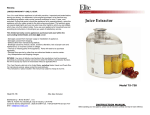
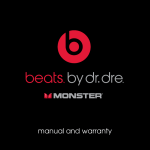

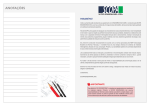
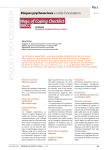

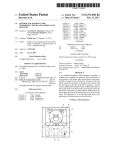
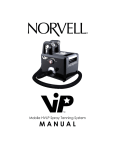
![Registry Manual []](http://vs1.manualzilla.com/store/data/005750489_1-c8586633e9f35db1a00a4874731a3151-150x150.png)
